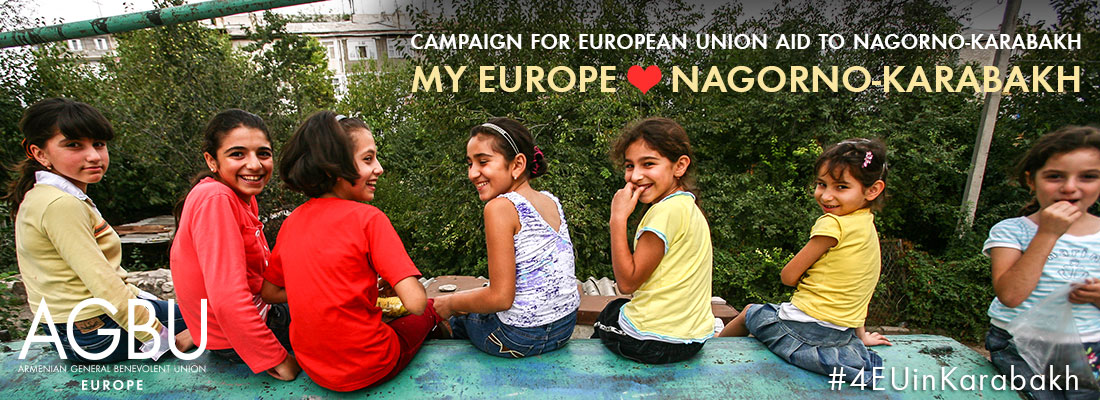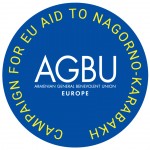The facts behind the video
The situation of Nagorno-Karabakh, the characteristics of the conflict and the specifics of European policy affecting it are not widely known in the European public. We provide below some sources that will help the viewer find out the facts behind each of the statements made in the video.
We have not sought to provide extensive sources, only sufficient references to allow the critical viewer or reader to find out about the facts that support the statements made in the video produced by the campaign. On most topics, an internet search should indeed allow the interested reader to find many more sources.
We also apologize for providing essentially English-language sources. We acknowledge that there is indeed much quality litterature on the subject in other languages, such as Russian.
Finally, we welcome constructive suggestions, information, questions or enquiries at 4EUinKarabakh@agbueurope.eu
The campaign will be happy to address requests for additional references and documentation.
- Statement 1: “The EU is a global power. It has official relations with almost every country in the world. It also provides assistance to populations in all countries in Europe and its surroundings, regardless of their regime.”
The facts: The EU generates a little less than a quarter of global output, or 24% of global GDP, for about 7% of the global population. By any measure, the EU remains a major force in the world, particularly in the European periphery.
The facts: EU institutions provided $ 15.5 billion in development aid in 2015, and 2.27 in humanitarian assistance in 2016. Total aid, including that provided by Member States, was a little more than $ 40 billion in 2015. This amount represented more than half -55%- of global develoment assistance worldwide. Europe is clearly the world’s major donor.
Sources: This EU web site provides detailed statistics on EU assistance around the world.
https://euaidexplorer.ec.europa.eu/
- Statement 2: “Entities that are in conflict with a central government also receive EU assistance, for instance:
Northern Cyprus”
The Facts: The EU allocates €30 million yearly to the “Turkish Cypriot Community”.
The source is the EC’s own web site: https://ec.europa.eu/cyprus/about-us/turkish-cypriots_en
“Palestine“
The facts: The annual EU contribution to the Palestinian authority is around €300 million.
The source: the relevant EU programmes are described at the following EU Commission web site:
https://ec.europa.eu/neighbourhood-enlargement/neighbourhood/countries/palestine_en
“Abkhazia”
The facts: Abkhazia is a separatist territory in conflict with Georgia. According to Carnegie Europe expert Tom de Waal, “Since 2008 and in the framework of the NREP, the EU has provided almost €40 million ($42 million) of funding for projects in Abkhazia or involving Abkhaz partners». The EU published an overview of the assistance provided which shows that € 23 million worth of projects were dedicated to the population in Abkhazia in the wake of the 2008 conflict in Georgia,
Sources: Tom de Waal’s report on « Enhancing the EU’s Engagement with Separatist»: http://carnegieeurope.eu/2017/01/17/enhancing-eu-s-engagement-with-separatist-territories-pub-67694
The note by the EU’s delegation in Georgia on EU Assistance to People Affected by Conflict in Georgia: http://eeas.europa.eu/archives/delegations/georgia/documents/projects/conflictassistance_2011overview_en.pdf
This note also provides details of assistance provided to South Ossetia, another separatist state in conflict with Georgia, not cited in the video.
“Transnistria“
The facts: Transnistria is a small separatist territory in Moldova. According to Carnegie Europe expert Thomas de Waal, “the territory is currently eligible to apply for technical help, but for domestic political reasons there is little uptake so far on making use of EU schemes.“ (see link under “Abkhazia” above)
Unlike Abkhazia and Nagorno-Karabakh, Transnistria is connected to the Moldovan economy through transport routes and trade. With the agreement of the EU and of the Moldovan government, it can export its products to the EU via Moldova, under the same conditions as Moldovan products. In fact, the EU has even encouraged the Transnistrian authorities to take part in trade talks with the EU, an unprecedented level of engagement with authorities in an unrecognized state in the former Soviet Union area.
Sources: Tom de Waal’s report mentionned above on « Enhancing the EU’s Engagement with Separatist»: http://carnegieeurope.eu/2017/01/17/enhancing-eu-s-engagement-with-separatist-territories-pub-67694
Regarding the issue of trade with the EU, see for instance: http://www.epc.eu/documents/uploads/pub_4257_transnistria.pdf
- Statement 3: “There is only one place where the EU provides absolutely no aid, and where its officials never go. That place is Nagorno-Karabakh, also known as Artsakh.”
The facts: the EU considers that it must request permission from the “recognized state”, Azerbaijan, before entering Nagorno-Karabakh or initiating activities there, such as development projects. A permission which Azerbaijan will not grant. This fact is well understood by all those following the EU’s policy. It was recently confirmed in an official response by the European Commission to a question asked by Member of the European Parliament Frank Engel.
Engel’s question:
“[...] no Commission or Council official, not even the EU Special Representative for the South Caucasus, is known to have visited this territory in decades. The EU has provided no assistance to the people of this region, in spite of the terrible toll of war.”
[Question 1] “is the Commission prepared to allow EU officials to travel to the territory of Nagorno-Karabakh?”
[Question 2] “Is the Commission willing to support the basic needs of the most vulnerable people in the region?”
Answer by the European Commission:
[1] «EU officials have raised the issue of travel to Nagorno-Karabakh (NK) with Azerbaijan and discussions on modalities continue. Meanwhile, the EU Special Representative maintains inclusive contacts with all stakeholders, including from NK», The Commission is referring to occasional meetings with Nagorno-Karabakh officials in Yerevan, the capital of Armenia. The Commission thus confirms that no EU officials go to NK.
[2] On the matter of assistance, the EU states that «In response to the conflict, the EU was a large provider of humanitarian assistance in the early 1990s and contributed to supporting the basic needs of the vulnerable people in the region. The EU also stands ready to provide assistance for reconstruction once a settlement is reached.» The EC confirms that there has been no aid since the early 90′s..
Sources: This parliamentary question can be found at: http://www.europarl.europa.eu/sides/getDoc.do?pubRef=-//EP//TEXT+WQ+E-2017-000951+0+DOC+XML+V0//EN&language=es
- Statement 4: “[Nagorno-Karabakh] is a mountainous territory in the South Caucasus, home to 150 000 people, mostly Armenians. Nagorno-Karabakh is one of several unrecognised states that emerged for the breakup of the Soviet Union in 1991. It is also one of the most disadvantaged areas in Europe.”
There is considerable information available on NK; most of it focusses on the conflict however, rather than on the situation of its population. As a result of the current blockade on Nagorno-Karabakh, for instance, there are very few NGO reports, and no reports by international agencies such as UNICEF or the UNDP regarding the situation of the population.
According to the NKR statistical office, average per capita income in NK is around € 2400 per year. That puts the country roughly on a par with the poorest in Europe, such as Moldova or Ukraine. A field visit will confirm that many people live in very difficult circumstances.
Source: http://stat-nkr.am
- Statement 5: “The territory has one of the world’s highest per capita mine casualty rates. Every year, civilians – mostly children and farmers – are victims of anti-personnel land mines.”
The facts: The Halo Trust is a British NGO that is leading the campaign for removing land mines around the world. It writes that the people of NK “have been haunted by landmines for more than two decades. In fact, Karabakh has the highest per capita incidence of landmine accidents in the world — a third of the victims are children.”
Source: https://www.halotrust.org/minefreenk/
- Statement 6: For 28 years, the inhabitants of this small territory have been living under a blockade, the Republic of Azerbaijan has deployed tremendous efforts to keep the population of Karabakh isolated from the rest of the world.”
Azerbaijan has blockaded Nagorno-Karabakh since 1989, two years before the end of the Soviet Union and before the conflict degenerated into war. This was a response to the first requests by the Supreme Soviet of the territory that it be transferred to the Armenian (Soviet) Republic. One New York Times article Date December 2, 1989, for instance, states that “The Russian republic, the largest of the 15 Soviet republics, has appealed to Azerbaijan to lift a renewed railway blockade against neighboring Armenia”.
The policy of blockading Nagorno-Karabakh continued after war. There is no question now of crossing the border between NK and Azerbaijan, where in fact the two armies face-off, sniper fire is frequent and clashes occasionally occur. Access to the rest of the world is possible only by road, through the Republic of Armenia. The road to the nearest airport is 8 hours long through the mountains.
The (now independent) Republic of Azerbaijan has however expanded its policy to seek to prevent access to Nagorno-Karabakh as much as possible and to prevent Karabakh from operating normally. Measures include:
– A policy of “blacklisting” individuals who travel to NK, particularly celebrities and public officials. These people are considered criminals under Azerbaijani law and risk arrest if they enter Azerbaijan.
– Attempts to extradite individuals who have been in Nagorno-Karabakh. A blogger by the name of Alexander Lapshin, for instance, was extradited from Belarus to Azerbaijan for no other crime than having travelled to, and written about, Nagorno-Karabakh.
– Retaliation against organisations that do operate in Nagorno-Karabakh. They are forced to close down their operations in Azerbaijan and leave.
– Retaliating against officials and institutions that meet with envoys from Nagorno-Karabakh anywhere in the world, or seek to develop working relations with them.
– The government of Azerbaijan threatens to shoot down any civilian or military aircraft flying over the territory. This makes air transport impossible and contributes to isolating the territory and stifling its economy.
Azerbaijan also uses its expansive network of influence, based mainly on oil interests and oil money (more on this below) in the service of this cause. The consequence of this policy is that no international organisation is present in Nagorno-Karabakh. Uniquely for a conflict area, not a single human rights or humanitarian organization is present in the territory, or reports on its situation.
Azerbaijan also refuses access to its territory to anyone suspected of being an ethnic Armenian.
Source [1]. There are numerous articles documenting the blockade policy as early as 1989 in the international media.
Here is just one article from 1989: “Russian Republic Urges Azerbaijan to End Armenia Blockade”, New york Times, Dec. 2, 1989. http://www.nytimes.com/1989/12/03/world/russian-republic-urges-azerbaijan-to-end-armenia-blockade.html
“Azerbaijan: Seven Years of Conflict in Nagorno-Karabakh”, a report by the NGO Human Rights Watch, 1994. https://www.hrw.org/sites/default/files/reports/AZER%20Conflict%20in%20N-K%20Dec94.pdf
Source [2] – The blacklist. Azerbaijan’s policy on access to NK is published at: http://mfa.gov.az/content/939
The blacklist is available at: http://mfa.gov.az/files/file/Arzuolunmaz_sexsler.pdf
Or https://report.az/en/foreign-politics/black-list-of-azeri-foreign-ministry-includes-435-people/
Sources [3]. Extraditing travellers. Blogger Alexander Lapshin’s case was extensively covered in the media. Here is one report in the Azerbaijani press dated May 2017: https://www.azernews.az/karabakh/113819.html
The case of MEPs Engel, Theocharous and Stetina has been less extensively covered internationally, but have been covered by the respective countries’ press: Luxembourg, the Czech Republic and Cyprus. Here is one report from Turkey: http://www.agos.com.tr/en/article/17821/azerbaijan-issues-arrest-warrant-for-observers.
Source [4]. The threat to shoot down Armenian civilian airplanes flying to NK was reported in some international media.
https://www.rferl.org/a/azerbaijan_threatens_to_shoot_down_karabakh_flights/2340659.html
Other sources. For more detailed accounts of the blockade please refer to some of the volumes in the bibliography.
- Statement 7: “Azerbaijan is an oil dictatorship led by Ilham Aliyev, in power since 2003. International NGO’s have repeatedly condemned the human rights violations in this country…”
Azerbaijan’s dismal record on human rights is well documented. Furthermore, power in the country is concentrated in the hands a small elite around President Ilham Aliyev.
There is no disputing the fact that Azerbaijan’s economy is dependent on oil. As of 2016, oil and gas made up 95% of Azerbaijan’s exports, 75 to 84% of its tax revenue and half the GDP (down from 65%).
The expression “oil dictatorship” suggests a relationship between the form of power and oil revenues. Oil revenues are an incentive for those in power to concentrate powers for their benefit; these revenues also provide them with the resources to buy consent and quell dissent. This phenomenon is often referred to nowadays as the “resource curse” in political sciences and in economics.
Sources [1]. Human Rights. Amnesty International: https://www.amnesty.org/fr/countries/europe-and-central-asia/azerbaijan/
Human Rights Watch: https://www.hrw.org/europe/central-asia/azerbaijan
In February 2017, a large coalition of Human Rights NGOs signed a letter denouncing the EU’s complacency in the face of Azerbaijan’s record. It is available at: https://www.hrw.org/news/2017/02/06/joint-ngo-letter-european-union-officials
Source [2]. Oil revenues. Information on the place of oi in Azerbaijan’s economy is abundant. Here is just one report. https://www.balcanicaucaso.org/eng/Areas/Azerbaijan/Azerbaijan-s-oil-dependence-123328
- Statement 8: “… where the level of hatred towards Armenians is such that beheading an Armenian is officially considered an act of patriotism.”
This phrase is a reference to the extensive hate speech against Armenians in Azerbaijan, and to its deadly consequences.
On hate-speech in Azerbaijan aimed at Armenians, the most authoritative source is the ECRI, a body dependent on the Council of Europe that investigates racism and discrimination of member states. In its 2016 report, it writes for instance that “political leaders, educational institutions and media have continued spreading hate speech. The pardon, release and promotion in 2012 of Ramil Safarov, who had been sentenced in Budapest to life imprisonment for the murder of an Armenian army officer, contributes to a sense of impunity for the perpetrators of racist crime. The report recommends that authorities put an end to the constant, mediatised use of hate speech, and rather promote mutual understanding and confidence.”
Source [1]. the ECRI report is available at: https://wcd.coe.int/ViewDoc.jsp?p=&id=2433387&Site=DC&direct=true
The relevant page on wikipedia is well documented and referenced: https://en.wikipedia.org/wiki/Anti-Armenian_sentiment_in_Azerbaijan
Source [2]. The Safarov affair may appear particularly outlandish to a reader coming across it for the first time. It is unfortunately authentic. We provide a few reports below.
http://www.aljazeera.com/indepth/opinion/2012/09/201293953565974.html
http://www.eurasianet.org/node/66015
http://karabakhfacts.com/tag/ramil-safarov-case/
- Statement 9: “The EU is afraid of upsetting Azerbaijan’s president. It wants Baku’s oil and gas.”
European companies and states have considerable interests in the extraction and export of Azerbaijani oil and gas. The British company BP is a major player there; French company Total is also a major investor.
Additionally, the European institutions and Member States are investing considerably in infrastructure to bring Azerbaijani oil and gas to Europe. This is presented as a way to diversify energy supplies and reduce dependence on Russian hydrocarbons.
Two major gas pipelines are currently under construction, TAP and TANAP.
Sources: http://www.tanap.com/tanap-project/why-tanap/
https://www.tap-ag.com/the-pipeline
These pipelines, as well as smaller ancillary pipelines, are fast-tracked as “Projects of European Interest” by the EU, and provided generous grant funding by the EU. The EU is thus putting public money, as well as its political weight, behind fossil fuel projets.
Sources: http://europa.eu/rapid/press-release_IP-17-280_en.htm
See a map of the infrastructure promoted by the EU: http://ec.europa.eu/energy/infrastructure/transparency_platform/map-viewer/main.html
According to the NGO BankWatch, total public loan funding to the Southern Gas corridor amounted to $ 8.27 billion. For the NGO however, “the Southern Gas Corridor, a system of mega-pipelines meant to bring gas from the Caspian region to Europe, is unnecessary in light of gas demand projections in the European Union’s 2050 Energy Strategy. Neither will the project make European countries independent from Russian gas. At the same time, the USD 45 billion investments will boost Azerbaijan’s dictatorial regime and cause damage to local communities and the environment in transit countries like Turkey and Italy.“
Sources: https://bankwatch.org/our-work/projects/southern-gas-corridor-euro-caspian-mega-pipeline
http://globalmotion.pageflow.io/walkingtheline#37823
Common oil and gas infrastructure, joint investments and the influence of oil giants such as BP provide Azerbaijan considerable leverage inside the European Union.
But there is more to it than oil. Over the years, NGOs, journalists and occasionally the courts have uncovered an extensive system of influence established in many European countries by Azerbaijan and relying various forms of corruption financed by oil money.
The NGO “European Stability Initiative” has carried out pioneering work in this field, and coined the now common phrase “Caviar Diplomacy”.
http://www.esiweb.org/index.php?lang=en&id=262
In 2017, the NGO coalition called “Civic Solidarity Platform” published a very well researched report which provides an overview of the Azerbaijani network of influence and corruption – or at least of what parts of it they have managed to uncover. The reports mentions the names of scores of politicians from many countries who are involved.
- Statement 10: “That is why Europe accepts to isolate the people of Karabakh. Do you agree that this is wrong? You can help change EU policy.”
Quite a few expert institutions who are not suspect to being partial on the issue of NK agree that engagement is the best policy when it comes to unrecognized territories. They argue that engagement is the humane thing to do; but they also argue that it is the most constructive approach to resolving the conflict. The two papers cited below make that case.
De Waal paper: http://carnegieeurope.eu/2017/01/17/enhancing-eu-s-engagement-with-separatist-territories-pub-67694
Think Tanks and experts are not alone however. The European Parliament and the EU Council have already expressed support in principle for the policy of engagement in NK.
The European Parliament has thus “call[ed] on the [European] Commission to explore the possibility of providing humanitarian aid and assistance to the population in the Nagorno-Karabakh region as well as to the IDPs and refugees who fled the region”
And in 2012, the EU Council of Ministers underlined its interest in engagement when it “underline[d] the need for unconditional access for representatives of the EU to Nagorno-Karabakh and surrounding regions”.
Source: http://www.consilium.europa.eu/uedocs/cms_data/docs/pressdata/EN/foraff/128197.pdf


